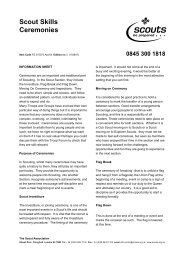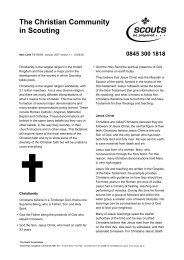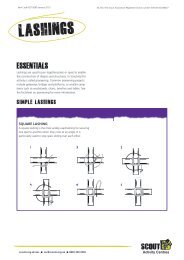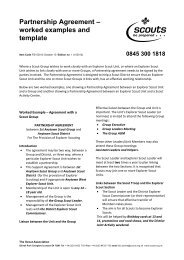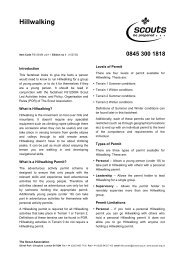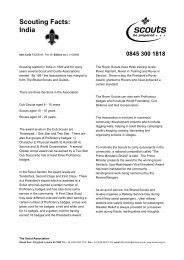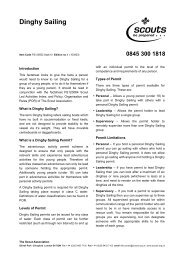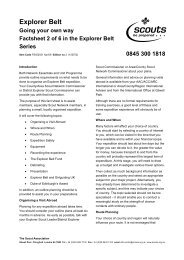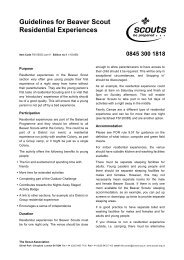Scout Association Swimming Pools - ScoutBase UK
Scout Association Swimming Pools - ScoutBase UK
Scout Association Swimming Pools - ScoutBase UK
Create successful ePaper yourself
Turn your PDF publications into a flip-book with our unique Google optimized e-Paper software.
<strong>Scout</strong> <strong>Association</strong><br />
<strong>Swimming</strong> <strong>Pools</strong><br />
Item Code FS120621 Jan/01 Edition no 4 (103804) 0845 300 1818<br />
Introduction<br />
This is the fourth edition of the factsheet which<br />
updates that coded FS120621 and dated Jan<br />
2000. It provides support to camp site<br />
management committees, managers and<br />
wardens, on the management of a swimming<br />
facility at a <strong>Scout</strong> <strong>Association</strong> owned or operated<br />
site.<br />
Further editions will be published in the light of<br />
experience from this edition. The publication of<br />
future editions will be notified in <strong>Scout</strong>ing<br />
Magazine, Talking Points and the Activities<br />
Newsletter.<br />
The sections printed in italics below are extracted<br />
from the current edition of Policy, Organisation<br />
and Rules (Rule 42.6). Attention is also drawn to<br />
the current edition of the companion factsheet<br />
<strong>Swimming</strong>.<br />
General<br />
All swimming facilities, pool, river, lake or beach<br />
require some measure of supervision, to promote<br />
safety when in use. These notes are aimed at<br />
those camp sites with a rectangular ‘tank’ type<br />
swimming facility. Management committees,<br />
managers and wardens of sites with other types of<br />
swimming provision must develop their own site<br />
specific written operating procedures guided by<br />
the information published here.<br />
The specific rule is:<br />
(d) <strong>Scout</strong>-owned swimming facilities<br />
Management Committees of <strong>Scout</strong> property with a<br />
swimming pool must operate the facility in<br />
accordance with the guidance contained within the<br />
publication Managing Health and Safety in<br />
<strong>Swimming</strong> <strong>Pools</strong> [HSE Books, HSG179]. They must<br />
have carried out a risk assessment, produced a<br />
written operating procedure and arranged for an<br />
attendant lifeguard to be on duty during every<br />
session. <strong>Scout</strong> parties using such a facility should<br />
do so in accordance with Rule 42.6(a). Further<br />
information and advice is given in the factsheet<br />
<strong>Scout</strong> <strong>Association</strong> <strong>Swimming</strong> <strong>Pools</strong> available from<br />
the <strong>Scout</strong> Information Centre.<br />
Health and Safety Implications<br />
The Health and Safety at Work etc Act 1974 (HSW<br />
Act) places duties on employers, employees and<br />
self-employed people. It protects not only people at<br />
work, including those undertaking voluntary work,<br />
but also the general public who may be affected by<br />
work activities. Many of the requirements in this<br />
legislation are qualified with ‘so far as is reasonably<br />
practicable’. The general requirements under the<br />
HSW Act are that equipment and plant are safe, the<br />
workplace is safe, there are safe systems of work<br />
and there is the provision of information, instruction,<br />
training and supervision needed to ensure that<br />
safety. Employees must do all that is reasonably<br />
practical to take care of their own health and safety<br />
and that of others, including those undertaking<br />
voluntary work, who may be affected by their acts or<br />
omissions at work and they must co-operate with<br />
their employees in complying with statutory health<br />
and safety obligations.<br />
Thus for a swimming pool within a camp site (with<br />
professional and/or volunteer staff) the same<br />
requirements of duty of care apply. The relevant<br />
guidance is contained within the publication<br />
Managing Health and Safety in <strong>Swimming</strong> <strong>Pools</strong>.<br />
It is not the intention of this factsheet to replicate<br />
the detail of the publication but more to headline<br />
the key elements, in relation to a <strong>Scout</strong> context.<br />
Risk Assessment<br />
A risk assessment is nothing more than a careful<br />
examination of all aspects of the operation and use<br />
of a swimming pool that might cause harm to people<br />
(users and staff). It has to be established whether<br />
enough precautions have been taken to prevent<br />
harm or whether more precautions need to be taken.<br />
To clarify two terms used:<br />
<br />
A hazard is anything that may cause harm.<br />
The <strong>Scout</strong> <strong>Association</strong><br />
Gilwell Park Chingford London E4 7QW Tel + 44 (0)20 8433 7100 Fax + 44 (0)20 8433 7103 email info.centre@scouts.org.uk www.scouts.org.uk
page 2 of 5<br />
<br />
A risk is a chance, whether great, medium or<br />
small, that someone will be harmed by a<br />
hazard.<br />
The HSE’s five step approach to risk is<br />
commended:<br />
<br />
<br />
<br />
<br />
<br />
Step 1: Look for the hazards.<br />
Step 2: Decide who might be harmed, and<br />
how.<br />
Step 3: Assess the risk and take appropriate<br />
action.<br />
Step 4: Record the findings.<br />
Step 5: Review the assessment from time to<br />
time and revise it if necessary.<br />
<br />
<br />
or other hazards associated with the pool<br />
surrounds?<br />
Pool depths and markings: are the depths of<br />
the pool clearly marked and are any safety<br />
notices with regard to suitable areas for<br />
diving, etc, clearly visible to all in the pool?<br />
Any other identified points.<br />
Who might be harmed by any of the hazards<br />
Identified?<br />
<br />
<br />
Anyone: unauthorised access to the pool (or<br />
plant).<br />
Swimmers: diving into unsuitable areas,<br />
getting tangled in any lane markers, being<br />
trapped by the suction at filtration points.<br />
Before writing the site specific operating<br />
procedure it is essential that a risk assessment is<br />
carried out.<br />
<br />
Lifeguards: is there cover from direct sunlight;<br />
if a vantage point is provided is this in good<br />
repair and safe to use.<br />
What hazards can be identified that could<br />
reasonably be expected to cause significant<br />
harm? Points that need to be considered are:<br />
<br />
<br />
Access: effective measures should be in<br />
place to prevent unauthorised access to a<br />
pool at any time when not in use. There could<br />
be a dedicated compound with a secure<br />
perimeter fence and a gate capable of being<br />
locked.<br />
Pool covers: if a pool cover is used as a<br />
primary or secondary means of preventing<br />
swimmer’s access, the covers should be of a<br />
type that can be secured continuously round<br />
the edge. They must be capable of<br />
supporting the weight of any person walking<br />
or falling on to them.<br />
<br />
The Public.<br />
What precautions have been taken against the<br />
risks that have been identified?<br />
<br />
<br />
Appropriate safety equipment supplied:<br />
safety lines in the form of soft buoyant aid or<br />
throwbag, safety pole with loop at the end,<br />
other soft buoyant aids. Method for the<br />
lifeguard to summon further assistance, in the<br />
event of an emergency.<br />
Written operating procedure.<br />
What further action is necessary to control the<br />
risk?<br />
<br />
Controls to limit access to pool.<br />
<br />
<br />
<br />
Plant or chemicals associated with the pool:<br />
what arrangements are made to limit the<br />
access to any filtration or heating plants?<br />
Where are the chemicals associated with any<br />
filtration plants stored and can they be<br />
accessed by non-authorised people?<br />
Chemical levels in the pool: are they at the<br />
right level and checked on a regular basis?<br />
Over and under use of chemicals can have<br />
marked effects on swimmers and has to be<br />
avoided.<br />
Pool surrounds: are these in good repair, are<br />
these surfaces non-slip; are there any steps<br />
<br />
Controls to limit access to plant and<br />
chemicals.<br />
What records are kept - by whom, and how often<br />
is the risk assessment reviewed?<br />
<br />
<br />
<br />
<br />
Records of use of pool.<br />
Records of accidents and near misses.<br />
Records of any maintenance carried out.<br />
Record of daily inspection of safety<br />
equipment.
page 3 of 5<br />
Standard Operating Procedure<br />
The written standard operating procedure is to be<br />
prepared and all those associated with the use,<br />
supervision or management of the pool (as part of<br />
the camp site facility) are to be familiar with its<br />
contents.<br />
In addition, there should be an emergency action<br />
plan which should list the actions to be taken in<br />
the event of a foreseeable emergency to include:<br />
<br />
<br />
Overcrowding.<br />
Disorderly behaviour.<br />
This should include:<br />
<br />
Lack of water clarity.<br />
<br />
<br />
<br />
<br />
<br />
<br />
<br />
<br />
<br />
<br />
Details of the pool, depth markings, safe<br />
diving areas.<br />
First aid provision.<br />
Safety equipment provided.<br />
Details of any specific identified risks,<br />
chemicals, filtration plant, etc, with associated<br />
rules and emergency procedure.<br />
Maximum numbers of swimmers permitted.<br />
Stipulation of the number of lifeguards to be<br />
on duty.<br />
Booking procedure for the use of the pool.<br />
Details of emergency signals to be used and<br />
when they should be demonstrated.<br />
Details of how attendant lifeguard(s) can<br />
summon further assistance in the event of an<br />
emergency.<br />
Location of emergency telephones.<br />
<br />
<br />
Injury to bather.<br />
Discovery of casualty in the water.<br />
The emergency action plan should detail the<br />
specific actions to be taken when an incident<br />
happens. The immediate follow-up and the<br />
subsequent review process for the incident.<br />
Lifeguard<br />
The HSE guidance is that constant poolside<br />
supervision by lifeguards provides the best<br />
assurance of pool users’ safety. Recent experience<br />
dictates that, as with the operation of ‘public’<br />
swimming pools, the onus is on the management<br />
committee of the property, which includes a pool, to<br />
arrange for (an) attendant lifeguard(s) to be on duty<br />
each time the pool is used for swimming.<br />
The option to use - in certain circumstances -<br />
occasional pool supervision, contained within the<br />
HSE guidance, is not appropriate for those<br />
operating pools on <strong>Scout</strong>-owned camp sites.<br />
The HSE guidelines provides information to<br />
determine the number of lifeguards required:<br />
<br />
<br />
<br />
An evacuation plan.<br />
Details of the reporting chain in case of an<br />
incident.<br />
Maximum working periods for the lifeguard.<br />
<br />
<br />
Firstly decide the maximum number of<br />
swimmers permitted to use the pool at the<br />
same time.<br />
Secondly determine the number of lifeguards<br />
required.<br />
<br />
<br />
<br />
Procedure to be used by the lifeguard (or<br />
other staff member) when opening-up the pool<br />
for use.<br />
Procedure to be followed if the lifeguard has<br />
to temporarily leave the area of the swimming<br />
pool.<br />
Procedure to be used by the lifeguard (or<br />
other staff member) when closing-down the<br />
pool after use.<br />
This calculation may have to be repeated: a<br />
reduction in the number of swimmers to match the<br />
number of lifeguards that can be provided.<br />
The management committee of the property,<br />
which includes a pool, will decide how the<br />
required attendant lifeguard(s) is(are) to be<br />
provided. In most instances the camp site will<br />
assume this responsibility and arrange for (a)<br />
member(s) of the staff - either paid or volunteer -<br />
to be trained as lifeguards.
page 4 of 5<br />
In some instances it may be decided to permit<br />
attendant, qualified lifeguards to be provided by<br />
user <strong>Scout</strong> parties. If this is the case, it has to be<br />
emphasised that there is an element of the<br />
training of lifeguards which is site specific. Thus<br />
such people will have to be briefed on the nature<br />
of the pool, how it is to be operated and the<br />
emergency procedures (the Standard Operating<br />
Procedure).<br />
All lifeguards must hold a valid Royal Life Saving<br />
Society <strong>UK</strong> National Lifeguard Qualification or<br />
<strong>Swimming</strong> Teachers’ <strong>Association</strong> National Aquatic<br />
Rescue Standard for Lifeguards in <strong>Swimming</strong><br />
<strong>Pools</strong> or equivalent. Such qualifications contain<br />
an element of training which is specific to the<br />
location - in relation to the nature of the pool, how<br />
it is to be operated and the emergency<br />
procedures (the Standard Operating Procedure).<br />
For any lifeguard on duty, it is important to include<br />
in the operating procedure the requirement to<br />
timetable both work and rest periods. The<br />
guidance provided in the HSE publication is that<br />
the duty period should not exceed 45 minutes with<br />
a break of at least the same length of time<br />
between such duty periods.<br />
<strong>Scout</strong> Use of the <strong>Swimming</strong> Pool<br />
For <strong>Scout</strong>s using such a swimming pool the rule is:<br />
(a) Leisure Centres and <strong>Swimming</strong> <strong>Pools</strong> with<br />
an Attendant Lifeguard<br />
When swimming takes place in leisure centres and<br />
swimming pools owned by other people or bodies,<br />
the leader must have read, accepted and<br />
implemented any safety rules and conditions<br />
contained in written operating procedures or<br />
displayed at the pool. The pool’s lifeguard will be on<br />
duty to supervise all swimmers; the leader, however,<br />
is still responsible for the good behaviour of a <strong>Scout</strong><br />
party.<br />
Use of the <strong>Swimming</strong> Pool by Outside Organisations<br />
The management committee of the property, which<br />
includes a pool, may decide that outside<br />
organisations may hire the facility. Within such an<br />
arrangement, the attendant lifeguard must be<br />
provided:<br />
site specific. Those from the outside organisation<br />
will have to be briefed on the nature of the pool,<br />
how it is to be operated and the emergency<br />
procedures (the Standard Operating Procedure).<br />
Parties of swimmers from other organisations,<br />
such as schools or youth groups, will have<br />
rules/regulations set by their parent organisation<br />
or local education authority. It is essential that<br />
these groups meet these rules/regulations in<br />
addition to The <strong>Scout</strong> <strong>Association</strong>’s requirement<br />
that there is an attendant lifeguard(s).<br />
For such users a suggested Form of Acceptance<br />
is included at the end of this factsheet.<br />
Use of the <strong>Swimming</strong> Pool for Activities other than<br />
<strong>Swimming</strong><br />
The management committee of the property,<br />
which includes a pool, may decide that the facility<br />
can be used for other activities - such as canoeing<br />
or sub-aqua.<br />
In such instances the activities should be<br />
conducted in accordance with The <strong>Scout</strong><br />
<strong>Association</strong>’s Rules and the guidelines provided<br />
by the appropriate National Governing Body. The<br />
management committee may decide that an<br />
additional requirement is that safety cover is<br />
provided by someone in addition to those<br />
engaged in the activity. For canoeing the<br />
management committee may be decided that in<br />
order to minimise damage to the structure of the<br />
pool than especially designed canoes (BAT<br />
canoes) must be used rather than the more<br />
traditional ones.<br />
PUBLICATION CROSS REFERENCE<br />
The current editions of:<br />
Policy, Organisation and Rules of The <strong>Scout</strong><br />
<strong>Association</strong>.<br />
<strong>Swimming</strong><br />
FS120620<br />
Managing Health and Safety in <strong>Swimming</strong> <strong>Pools</strong><br />
[HSE Books, HSG 179].<br />
Safe Supervision - ASA/ISTC/ISLM/RLSS <strong>UK</strong><br />
ISBN 1 900738 20 1<br />
Attachment:<br />
<br />
<br />
either by the camp site.<br />
or by the outside organisation.<br />
Suggested Form of Acceptance for Use of the<br />
<strong>Swimming</strong> Pool (Non <strong>Scout</strong> Use).<br />
If the latter it has to be emphasised that there is<br />
an element of the training of lifeguards which is
page 5 of 5<br />
Suggested Form of<br />
Acceptance for Use of <strong>Swimming</strong> Pool (Non-<strong>Scout</strong> Use)<br />
I ............................................................................................................................................... (name)<br />
of ........................................................................................................... (School or other organisation)<br />
confirm that I have received a copy of the Standard Operating Procedure relating to the swimming pool<br />
at ………………………………………………… Camp Site. There will be ....................... swimmers.<br />
I confirm that the safety requirements of The <strong>Scout</strong> <strong>Association</strong> and my own school/organisation will be<br />
met:<br />
either<br />
I am providing ..................... people of who hold a Royal Lifesaving Society <strong>UK</strong> National Pool Lifeguard<br />
Qualification, <strong>Swimming</strong> Teachers’ <strong>Association</strong> National Aquatic Rescue Standard for Lifeguards<br />
or equivalent (please state qualification): .......................................................................................................<br />
or<br />
I am making use of the lifeguard cover provided by the Camp Site and undertake that the requirements<br />
of the person(s) on duty will be carried out.<br />
(delete as appropriate)<br />
.................................................................. ..................................................................<br />
Date<br />
Signature<br />
(To be printed on campsite’s own paper)



